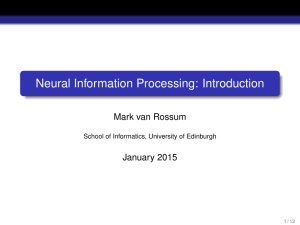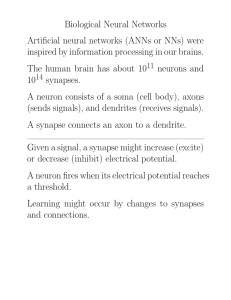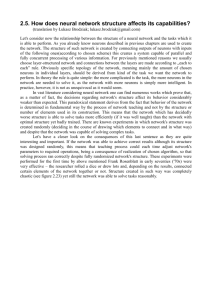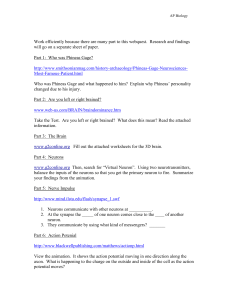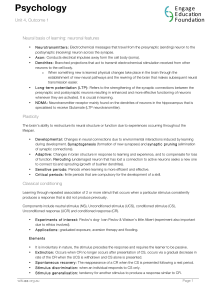Behaviour not dependent on learning
advertisement
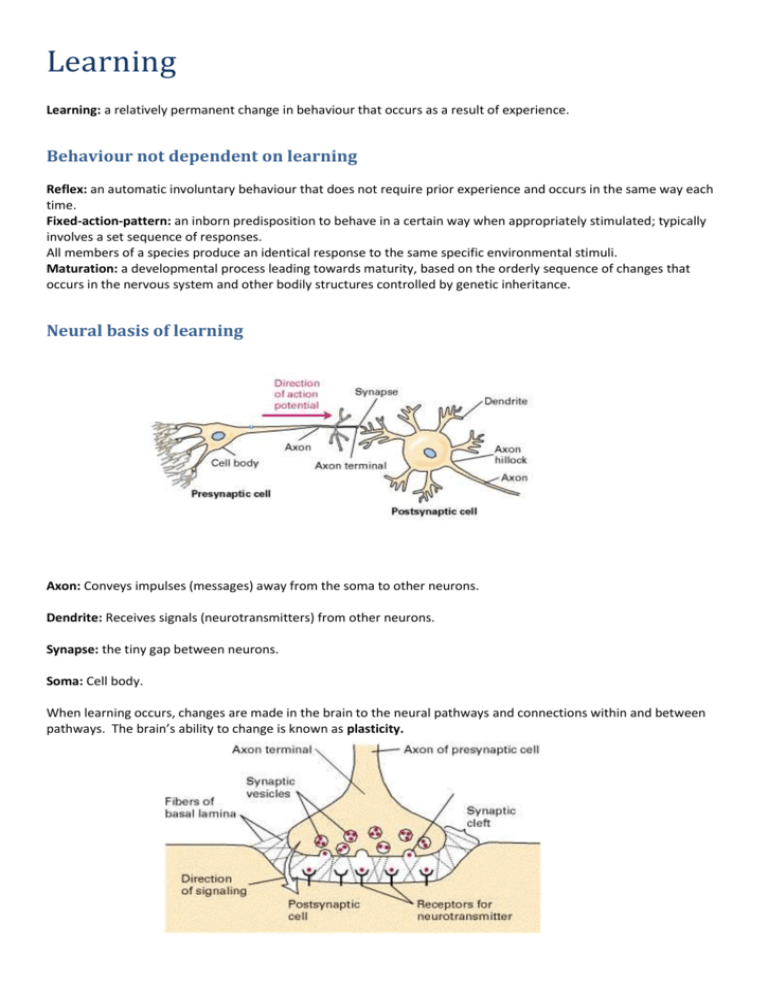
Learning Learning: a relatively permanent change in behaviour that occurs as a result of experience. Behaviour not dependent on learning Reflex: an automatic involuntary behaviour that does not require prior experience and occurs in the same way each time. Fixed-action-pattern: an inborn predisposition to behave in a certain way when appropriately stimulated; typically involves a set sequence of responses. All members of a species produce an identical response to the same specific environmental stimuli. Maturation: a developmental process leading towards maturity, based on the orderly sequence of changes that occurs in the nervous system and other bodily structures controlled by genetic inheritance. Neural basis of learning Axon: Conveys impulses (messages) away from the soma to other neurons. Dendrite: Receives signals (neurotransmitters) from other neurons. Synapse: the tiny gap between neurons. Soma: Cell body. When learning occurs, changes are made in the brain to the neural pathways and connections within and between pathways. The brain’s ability to change is known as plasticity. When neurons communicate with each other, they do this by sending neurotransmitters across the synapse. Three components to the synapse. - The synaptic gap: the tiny space between the axon (presynaptic neuron) and the dendrite (postsynaptic neuron) - Axon ending: Presynaptic neuron ‘sending’ the message or neural impulse - Dendrite: Postsynaptic neuron ‘receiving’ the message or neural impulse Synaptic formation occurs when neurotransmitters are released across the synapse and dendrites grow new branches and lengthen in response. When pathways are not used the dendrites are pruned. Hebb: neurons that fire together, wire together Neurons that activate at the same time, strengthen neural pathways and connections. Neurons not activated (perhaps through disuse) weaken connections. Synaptogenesis: synapse formation. Synaptogenesis occurs throughout a healthy person’s lifespan, but it occurs most rapidly during early brain development, beginning at about two months before birth until approximately two years after birth. Long-term potentiation (LTP): The long-lasting strengthening of the synaptic connections of neurons, resulting in enhanced functioning of neurons when activated. LTP improves the ability of the presynaptic and postsynaptic neurons to communicate with one another at the synapse. LTP is crucial to learning, as is the hippocampus – Richard Morris “Water maze” experiment (1982). Hippocampus is crucial to learning and memory and therefore LTP. NMDA is a neurotransmitter receptor on the dendrite (found mostly around the hippocampus). It receives the neurotransmitter ‘glutamate’ and has an important role in LTP. Neurotransmitters Neurotransmitter Acetylcholine Dopamine Seratonin Gamma-amino butyric acid (GABA) Glutamate Location of Neurons Effects Motor neurons of PNS; brainstem; Excitatory effect at synapse with voluntary base of forebrain (hippocampus) muscle, causing contraction; role in hippocampus of brain in memory consolidation CNS Mainly inhibitory – involved in voluntary movements, learning, memory, emotional arousal and feelings of pleasure. Deficiencies are linked to Parkinson’s disease. Inhibits glutamate release. Excess linked to schizophrenia. CNS Mainly inhibitory – involved in sleep, arousal levels and emotional experience. Deficiencies linked to anxiety, mood disorders and insomnia. Interneurons in many CNS sites Mainly inhibitory – involved in the experience of a range of emotions; acts as a hormone to stimulate the sympathetic NS. Interneurons in many CNS sites; Excitatory – communication between adjacent cerebral cortex; spinal cord brain cells. Too little results in lack of signalling. Excess results in self-destruction of neurons, death of adjacent cells. Inhibitory – blocks the transmission of information from one neuron to another. Excitatory – assists transmission of information from one neuron to another. Brain Areas involved in Learning Cerebellum: a structure attached to the rear of the brainstem that helps coordinate voluntary movement and balance. The cerebellum primarily regulates posture, muscle tone and muscular coordination. The cerebellum also stores memories related to skills and habits. The cerebellum is also implicated in neural circuits involved in simple stimulus-response learning (classical conditioning). Limibic system: composed of a number of structures that form a doughnut-shaped neural system between the hindbrain and the cerebral hemispheres. Hippocampus and amygdale are the key structures. Hippocampus: critical to spatial learning and awareness because it plays a role in monitoring locations in space and the relationship between them. Amygdala: aids survival behaviour and it is involved in the memory and learning of emotional responses, particularly related to aggression and fear. The amygdale provides a primitive ‘quick pathway’ to the cortex, which enables us to react to dangerous stimuli before we have fully comprehended the situation. When the amygdale is stimulated, animals will respond with aggression or rage. Frontal lobes: crucial to cognitive behaviours such as learning, memory, planning, problem-solving, speech production and the execution of daily activities. Also crucial to motor functions. Neuroplasticity The brain has the ability to change its structure and relocate functions to different areas and /or neuronal networks Developmental plasticity: changes in neural connections during development as a result of environmental interactions as well as neural changes due to learning. Developmental plasticity is specific to the change in neurons and synapse connections as a consequence of developmental processes. Adaptive plasticity: changes in neural connections in response to changing environmental conditions (such as brain injury), as well as neural changes induced by learning. Changes occurring in the brain’s neural structure to enable adjustment to experience, to compensate for lost function and/or to maximise remaining function in the event of brain damage. Adaptive plasticity: reroutes neural pathways around damaged areas, sprouts new dendrites on damaged neurons to re-establish the pathway, or other brain areas take over the functioning of the damaged area. Timing of experiences: Sensitive periods A period in development when an organism is more responsive to certain environmental stimuli or experiences (windows of opportunity for learning). There are two types of learning: Experience-expectant learning: takes place when the brain encounters the experience that is expected, ideally in a sensitive period because this is the best time for it to occur. Usually during infancy and early childhood. If the experience does not occur when expected, learning may not occur and brain development will not occur as it should. Eg: learning language, coordination of vision and movement. Experience-dependent learning: refers to learning that ‘depends’ on exposure to specific ‘experiences’ at any time during an individual’s development. Eg: learning to read and write in your native language or sing and read music. Critical periods A specific period in development during which an organism is most vulnerable to the deprivation or absence of certain environmental stimuli or experiences. More common in animals. Eg: an eye held closed from birth will not develop normally. Imaging technologies Modern brain imaging technologies such as CT scans, PET scans, SPECT scans, MRI scans and fMRI scans provide clear evidence that, during learning, changes occur in neurons that can result in permanent structural and functional brain changes. Learning theory 1 – Classical Conditioning Classical conditioning, studied by Pavlov, occurs when a neutral stimulus (NS) is associated with an unconditioned stimulus (UCS) to elicit a response. The UCS causes a reflex response called the unconditioned response (UCR). If the NS is consistently paired with the UCS, it becomes a conditioned stimulus (CS) capable of producing a response by itself. This response is a conditioned (learnt) response (CR). When the CS is followed by the UCS, conditioning is reinforced (strengthened). When the CS is repeatedly presented alone, conditioning is extinguished (weakened or inhibited). After extinction seems to be complete, a rest period may e followed by the temporary reappearance of a CR. This is called spontaneous recovery. Though stimulus generalisation, stimuli similar to the CS will also produce the CR. Generalisation gives way to stimulus discrimination when an organism demonstrates the CR only when the specific CS is present. Stimulus: any event that elicits (produces) a response from an organism. Response: a reaction by an organism to a stimulus. UCS: any stimulus that consistently produces an UCR. UCR: the response that occurs automatically as a result of the UCS. CS: the stimulus that is neutral at the start of classical conditioning and does not normally produce the UCR, but eventually becomes associated with the UCS. CR: the learned or acquired response to the CS. Key processes in classical conditioning Acquisition: is the overall process during which an organism learns to associate two events (the CS and UCS). The CS and UCS are presented closely together and the duration of acquisition is the number of trials it takes for the CR to be acquired. Extinction: the gradual decrease in the strength or rate of a CR that occurs when the UCS is no longer presented. When a CR no longer follows presentation of the CS. Spontaneous recovery: is the reappearance of a CR when the CS is presented, following a rest period, after the CR appears to have been extinguished. Stimulus generalisation: the tendency for another stimulus – one that is similar to the original CS – to produce a response that is similar to the CR. Stimulus discrimination: Occurs when a person or animal responds to the CS only, but not to any other stimulus that is similar to the CS.


